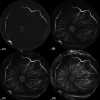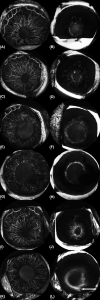Iris angiography in ADAMTS10 mutant dogs with open-angle glaucoma (ADAMTS10-OAG)
- PMID: 36855027
- PMCID: PMC11109342
- DOI: 10.1111/vop.13075
Iris angiography in ADAMTS10 mutant dogs with open-angle glaucoma (ADAMTS10-OAG)
Abstract
Objective: To evaluate anterior segment angiographic findings in hypertensive ADAMTS10-open-angle glaucoma (ADAMTS10-OAG) eyes as compared to normotensive control eyes.
Animals studied: Nine ADAMTS10-OAG beagles and four wild-type control dogs.
Procedures: Anterior segment angiography was performed under general anesthesia following intravenous injection of indocyanine green (ICG; 1 mg/kg) and sodium fluorescein (SF; 20 mg/kg) using a Heidelberg Spectralis® confocal scanning laser ophthalmoscope. Time to onset of iridal angiographic phases and the presence/severity of dye leakage into the iris stromal and/or aqueous humor were recorded. Group findings were compared, and multiple linear regression analysis was performed to identify potential factor associations with disease status.
Results: Time to onset of all angiographic phases visualized using ICG was significantly prolonged while time to onset of SF leakage into the aqueous humor was significantly reduced in glaucomatous eyes compared to controls. Only glaucomatous eyes (n = 9) demonstrated evidence of SF stromal leakage. Mean intraocular pressure (IOP) and age were significantly higher, while mean cardiac pulse was significantly lower in glaucomatous eyes compared to controls. Blood pressure and ocular perfusion pressure were not significantly different between groups. Multiple linear regression analysis, controlling for age, IOP, and pulse demonstrated glaucoma, was not predictive of the time to onset of any angiographic phase, stromal, or aqueous humor leakage. However, pulse was a significant factor contributing to the severity of aqueous humor leakage.
Conclusions: A compromised vascular supply to the anterior segment exists in dogs with ADAMTS10-OAG. These observations warrant further exploration of what role altered perfusion and/or disruption to the blood-aqueous barrier may play.
Keywords: ADAMTS10-open-angle glaucoma (ADAMTS10-OAG); angiography; canine; uvea.
© 2023 The Authors. Veterinary Ophthalmology published by Wiley Periodicals LLC on behalf of American College of Veterinary Ophthalmologists.
Conflict of interest statement
The authors declare no conflicts related to this study. Dr. Komáromy received research funding from PolyActiva Pty. Ltd. and CRISPR Therapeutics while the presented work was conducted. He also serves as a consultant for Reichert Technologies and Editor‐in‐Chief of Veterinary Ophthalmology.
Figures





References
-
- Gelatt KN, Mackay EO. Prevalence of the breed‐related glaucomas in pure‐bred dog in North America. Vet Ophthalmol. 2004;7:97‐111. - PubMed
-
- Tham YC, Li X, Wong TY, Quigley HA, Aung T, Cheng CY. Global prevalence of glaucoma and projections of glaucoma burden through 2040: a systematic review and meta‐analysis. Ophthalmology. 2014;121(11):2081‐2090. - PubMed
-
- Miller PE. The glaucomas. In: Maggs DJ, Miller PE, Ofri R, eds. Slatter's Fundamentals of Veterinary Ophthalmology. 5th ed. Elsevier; 2013:247‐271.
MeSH terms
Substances
Grants and funding
LinkOut - more resources
Full Text Sources
Medical

